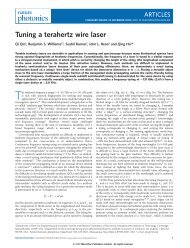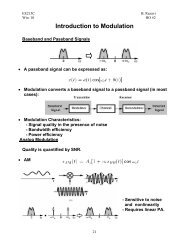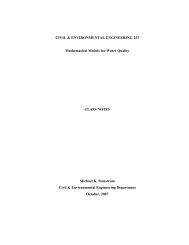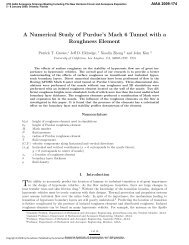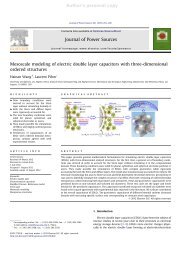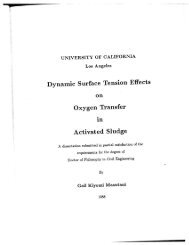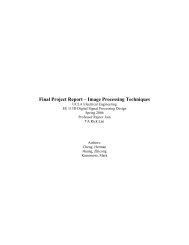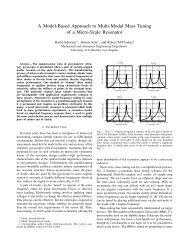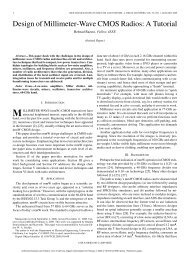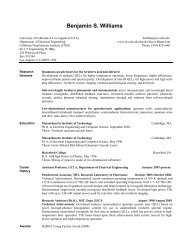Nuclear norm system identification with missing inputs and outputs
Nuclear norm system identification with missing inputs and outputs
Nuclear norm system identification with missing inputs and outputs
Create successful ePaper yourself
Turn your PDF publications into a flip-book with our unique Google optimized e-Paper software.
2.2. System realizationOnce an estimate of range(O r ) has been determined as described in the previous section,it is straightforward to calculate a <strong>system</strong> realization <strong>and</strong> an estimate of the initial state (aswell as the entire state sequence). Several methods have been proposed for this that differin the order in which the estimates of the <strong>system</strong> matrices <strong>and</strong> state sequence are computed;see [7, Section 10.6] <strong>and</strong> [8, Section 9.6.2]. Here we outline the main steps of the realizationmethod described in [7].Let V ∈ R rnp×nx be a matrix whose columns form a basis of our estimate of range(O r ).Partition V in r block rows V 0 , ..., V r−1 of size n p ×n x . Then one can take as estimates ofC <strong>and</strong> A the matrices∑r−1Ĉ = V 0 , Â = argmin ‖V i −V i−1 Â‖ 2 F, (12)where ‖·‖ F denotes the Frobenius <strong>norm</strong>. From Ĉ <strong>and</strong> Â, estimates of B, D, <strong>and</strong> x(0) canbe computed by solving a least-squares problem:(ˆB, ˆD,ˆxN+r−2∑0 ) = argmin ‖ĈÂkˆx 0 +k=0i=1∑k−1ĈÂk−i 2 ˆBu(i)+ ˆDu(k)−y(k)‖ 2 . (13)If a model of the noise in (2) is required, it can be obtained by first estimating the statesequence X 0,1,N <strong>and</strong> from this an estimate of the process <strong>and</strong> measurement noise covariances.The Kalman gain K can then be determined by solving a discrete-time Riccati equation(see [8, page 333]).3. Identification by nuclear <strong>norm</strong> optimizationThe key step in the subspace methods described above is an SVD of the matrix G definedin(9), usedtoestimatetherangeoftheextendedobservabilitymatrix. Theuseofinstrumentalvariables guarantees that the estimate is consistent, i.e., range(O r ) is estimated correctlyin the limit as N goes to infinity. However for finite data there is no guarantee of optimality.In particular, a matrix V ∈ R rnp×nx whose columns span the subspace range(W1 −1 P) definedin (11), does not necessarily possess the shift structure V i = V i−1 A between the block rowsV i of an extended observability matrix.The reliance on the SVD for the low-rank approximation also makes it difficult to extendthe subspace methods to problems <strong>with</strong> <strong>missing</strong> input or output measurement data(for which parts of the matrices Y 0,r,N <strong>and</strong> U 0,r,N are unknown), to incorporate prior knowledge(for example, bounds on the <strong>outputs</strong>), or to add regularization terms on the model<strong>outputs</strong> <strong>and</strong> <strong>inputs</strong>. Minimizing the nuclear <strong>norm</strong> provides an interesting alternative, asa heuristic for low-rank approximation problems that cannot be h<strong>and</strong>led via an SVD, inparticular, approximation problems <strong>with</strong> structured low-rank matrices <strong>and</strong> problems thatinclude additional constraints or objectives. In this section, we discuss several variationsof the subspace methods of section 2 based on this heuristic. We focus on applications to<strong>identification</strong> <strong>with</strong> <strong>missing</strong> data. Various other applications of the nuclear <strong>norm</strong> heuristic in<strong>system</strong> <strong>identification</strong> are discussed in [25, 15, 16, 17, 11].6i=0



